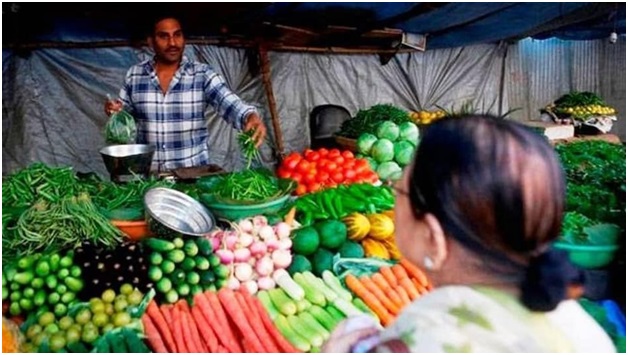Latest NSO Data on Inflation in India (The Hindu)

- 14 Sep 2023
Why it is in News?
- Recent data from the National Statistical Office (NSO) reveals that India's retail inflation rate decreased to 6.83% in August.
- This decline came after hitting a 15-month high of 7.44% in July 2023, primarily because of falling prices of food items, particularly vegetables.
- However, it's worth noting that the inflation rate still remains above the upper limit of the Reserve Bank of India's (RBI) medium-term inflation target range of 4+/-2%.
Key Points from the Recent NSO Data:
- In August 2023, retail inflation stood at 6.83%, marking the fourth instance this year and the seventh since August 2022 where it exceeded the upper limit of the target.
- Policymakers are increasingly concerned about high inflation rates.
- In its recent monetary policy review, the RBI maintained the key repo rate at 6.50% but raised the inflation projection for FY2024 from 5.1% to 5.4%.
- In the Index of Industrial Production (IIP), manufacturing showed improvement, rising to 141.2 in July from 135 a year ago and 141.1 in the previous month.
- Of concern, consumer durables contracted by 2.7% year-on-year in July 2023, indicating weaknesses and imbalances in consumption demand.
Key Insights from the Recent NSO Data:
- Consumer Confidence Declines: In August 2023, consumer sentiment dropped by 1.5%, breaking a streak of continuous increases since January 2023.
- This decline can impact the Indian economy and businesses, particularly in anticipation of the upcoming festive season.
- A significant contributor to this drop is a decrease in consumers' intentions to buy consumer durables like cars and TVs.
- This pessimism is not only due to stagnant perceived incomes but also concerns about future earnings.
- Persistent Inflation: According to RBI projections, inflation is expected to remain above 5% until the first quarter of 2024-25, with the likelihood of reaching 6.2% in the current quarter (July-September), which is beyond the RBI's comfort zone.
- Although overall food inflation has moderated, certain food items like cereals, pulses, and milk are experiencing upward price momentum.
- Factors such as irregular rainfall and low reservoir levels pose further risks to food inflation.
- Additionally, the recent surge in global crude oil prices is a cause for concern. However, the continuing deflation in the Wholesale Price Index (WPI) will have a delayed impact on Consumer Price Index (CPI) inflation.
- The government's decision to reduce cooking gas prices by Rs 200 per cylinder is expected to benefit domestic LPG consumers and those under the Pradhan Mantri Ujjwala Yojana (PMUY).
- India's GDP Growth Prospects: India's potential GDP growth rate has steadily decreased from around 8% just before the Global Financial Crisis of 2008-09 to 6% before the Covid pandemic.
- The potential GDP growth rate represents the rate at which an economy can expand without causing high inflation.
- The temporary increase in India's GDP growth rates in 2020-21 was primarily due to a lower base.
- The Indian economy faces various challenges, including a slowing global economy, elevated oil prices, and climate change. Economists estimate that, under a business-as-usual scenario, India's economy cannot grow more than 5% over the next decade.
- While this growth rate may be attractive from a global perspective, it may not be sufficient to meet the employment needs of India's large youth population.
What is Inflation?
- Inflation signifies an increase in prices, resulting in a decrease in the purchasing power of money over time.
- The rate at which purchasing power diminishes is measured by tracking the average price increase of a specific set of goods and services over a specified period.
- This price hike, typically expressed as a percentage, signifies that a unit of currency can purchase fewer goods and services compared to previous periods.
- In contrast, deflation occurs when prices fall, leading to an increase in purchasing power.
What are the causes of inflation?
- Demand-Pull Inflation: This occurs when the demand for goods and services exceeds their supply.
- When demand is high and supply is limited, businesses often raise prices, leading to inflation.
- It's often associated with strong economic growth.
- Cost-Push Inflation: In this scenario, rising production costs, such as increased wages or the cost of raw materials, force businesses to raise prices to maintain their profit margins.
- Oil price spikes are a classic example of cost-push inflation.
- Built-In Inflation: Sometimes called wage-price inflation, this happens when workers consistently demand higher wages to keep up with rising prices.
- Businesses then raise prices to cover increased labor costs, creating a cycle of inflation.
Categories:
- Consumer Price Index (CPI): This index calculates the weighted average of prices for a basket of goods and services at the consumer or retail level.
- Wholesale Price Index (WPI): The WPI monitors price changes for goods in stages before reaching the retail level.
Inflation Targeting in India:
- The RBI Act of 1934 establishes a legal and institutional framework for ensuring price stability while also considering growth objectives.
- In 2016, the Finance Act amended the RBI Act to establish a Monetary Policy Committee (MPC).
- The MPC issues a bi-monthly Monetary Policy Report to set India's benchmark interest rate, enhancing transparency and accountability in the country's monetary policy.
- The current mandate of the MPC is to maintain an annual inflation rate of 4% (with a tolerance range of +/-2%).
- If inflation exceeds this range for three consecutive quarters, the committee is accountable to the Government of India.
Mains Question:
- How does the RBI's inflation targeting framework impact India's economic stability and growth? Discuss the tools and effectiveness of RBI's strategies in controlling inflation. (10 M)
